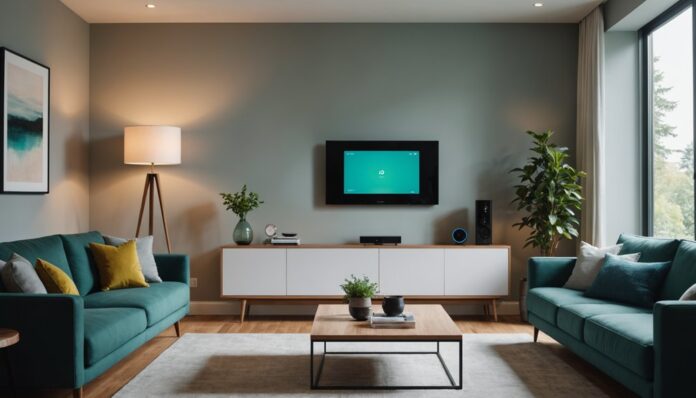Energy-efficient devices are changing the smart home environment. By harnessing advanced technologies, these devices greatly reduce energy consumption while elevating comfort and convenience. Smart thermostats, for instance, learn household schedules to optimize heating and cooling. Energy-efficient lighting solutions, meanwhile, employ LED technology and motion sensors to minimize waste. As households increasingly adopt these devices, they can expect remarkable reductions in energy bills and a more sustainable living environment.
Highlights
- Smart thermostats optimize heating and cooling by learning household schedules and preferences to prevent energy waste.
- Energy-efficient lighting solutions utilize LED technology and motion sensors to reduce energy consumption and enhance comfort and security.
- Intelligent home automation systems combine technologies for a seamless living experience, enabling remote management of lighting, temperature, and appliances.
- Energy-saving smart plugs and outlets control and monitor appliances’ energy usage, eliminating standby power consumption and enabling scheduling of on/off times.
- Eco-friendly smart home appliances reduce energy consumption and promote environmentally responsible practices through sustainable kitchen gadgets and cleaning appliances.
Smart Thermostats for a More Efficient Home
While traditional thermostats rely on manual adjustments to regulate temperature, smart thermostats take a more innovative approach by learning a household’s schedule and preferences to optimize heating and cooling.
With smart scheduling capabilities, these thermostats can adjust the temperature to a household’s daily routine, ensuring that energy is not wasted when no one is home.
Smart thermostats provide precise temperature control, allowing homeowners to set specific temperatures for different times of the day. This not only saves energy but also creates a more comfortable living environment.
Homeowners can access and adjust their smart thermostat remotely, ensuring that their home is always at the perfect temperature.
Energy-Efficient Lighting Solutions
In addition to optimizing temperature control, smart home energy efficiency can be additionally enhanced with advanced lighting solutions.
One effective approach is to employ LED technology, which consumes considerably less energy than traditional incandescent bulbs and lasts longer.
Smart lighting systems can also be integrated with motion sensors to automatically turn off lights in unoccupied areas, minimizing unnecessary energy consumption. This not only reduces energy waste but also provides homeowners with a sense of comfort and security.
Moreover, smart lighting systems can be controlled remotely, allowing homeowners to schedule and adjust lighting preferences to suit their daily routines.
Intelligent Home Automation Systems
The integration of intelligent home automation systems is a key component of energy-efficient smart homes. These systems combine various technologies to create a seamless and interconnected living experience. Homeowners can manage lighting, temperature, and appliances remotely, optimizing energy consumption and enhancing comfort.
Automated security features, such as motion detection and smart locks, provide an added layer of protection and peace of mind.
Climate control is another essential aspect of intelligent home automation systems. Smart thermostats learn occupants’ schedules and preferences, adjusting the temperature accordingly to minimize energy waste. This not only reduces energy bills but also contributes to a more sustainable lifestyle.
Energy-Saving Smart Plugs and Outlets
Smart plugs and outlets are simple yet effective devices that play an essential role in reducing energy consumption in smart homes.
These devices enable homeowners to control and monitor their appliances’ energy usage, leading to significant smart plug benefits. By automating outlets, homeowners can eliminate standby power consumption, also known as vampire power, which can account for up to 10% of a home’s total energy usage.
Outlet automation also allows homeowners to schedule on/off times for their appliances, optimizing energy usage and reducing waste. Additionally, smart plugs can be controlled remotely, ensuring that devices are turned off when not in use, resulting in substantial energy savings.
Eco-Friendly Smart Home Appliances
While homeowners can make a significant impact on energy consumption by incorporating smart plugs and outlets, another essential step towards a more sustainable future is adopting eco-friendly smart home appliances.
These devices not only reduce energy consumption but also promote environmentally responsible practices. Sustainable kitchen gadgets, such as smart slow cookers and energy-efficient refrigerators, are designed to minimize waste and optimize energy use.
Additionally, eco-friendly cleaning appliances like robot vacuum cleaners and steam mops reduce the need for harsh chemicals and excessive water usage.
By integrating these appliances into their homes, individuals can contribute to a more sustainable future while also enjoying the benefits of a smarter, more efficient living space.
This shift towards eco-friendly appliances is a significant step towards creating a more environmentally conscious community.
Conclusion
Energy-efficient devices for the smart home effectively reduce energy consumption while enhancing household comfort and convenience. By integrating smart thermostats, energy-efficient lighting solutions, intelligent home automation systems, energy-saving smart plugs and outlets, and eco-friendly smart home appliances, households can greatly lower their energy bills and cultivate a sustainable lifestyle. These innovative devices promote environmentally conscious living and are essential components of modern, energy-efficient homes. They offer a practical solution to conserving energy for future generations.


